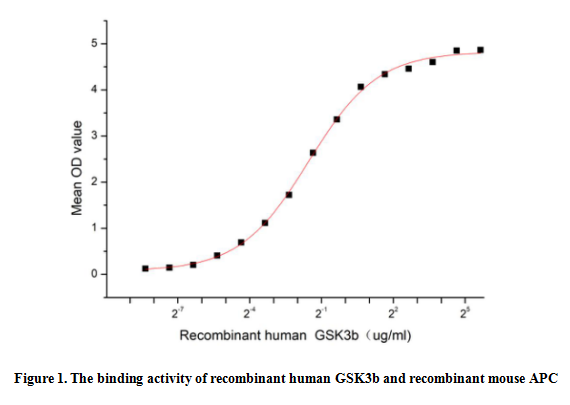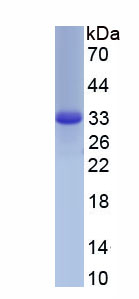Active Glycogen Synthase Kinase 3 Beta (GSK3b) 

Serine/threonine-protein kinase GSK3B
Overview
Properties
- Product No.APD317Hu01
- Organism SpeciesHomo sapiens (Human) Same name, Different species.
- ApplicationsCell culture; Activity Assays.
Research use only - DownloadInstruction Manual
- CategoryEnzyme & Kinase
- Buffer FormulationPBS, pH7.4, containing 0.01% SKL, 5% Trehalose.
- Traits Freeze-dried powder, Purity > 95%
- Isoelectric Point7.7
Sign into your account
Share a new citation as an author
Upload your experimental result
Review

Contact us
Please fill in the blank.
Activity test

Glycogen synthase kinase 3β (GSK3β) is a multifunctional protein kinase that targets Ser/Thr residues with a priming phosphorylation at the fourth amino acid on the C-terminal side. GSK3β is ubiquitously expressed in all types of cells and tissues and is particularly abundant in the brain. GSK3β regulates many cellular functions, including cell proliferation, cell survival, gene expression, cellular architecture, neural development and plasticity etc. Besides, Adenomatosis Polyposis Coli Protein (APC) can bind to GSK3β to form complexes with specific functions. This complex plays a central role in the Wnt signaling pathway, which is involved in regulating the stability of β-catenin, thus a functional ELISA assay was conducted to detect the interaction of recombinant human GSK3b and recombinant mouse APC. Briefly, GSK3b was diluted serially in PBS with 0.01% BSA (pH 7.4). Duplicate samples of 100 μl were then transferred to APC-coated microtiter wells and incubated for 1h at 37℃. Wells were washed with PBST and incubated for 1h with anti-GSK3b pAb, then aspirated and washed 3 times. After incubation with HRP labelled secondary antibody for 1h at 37℃, wells were aspirated and washed 5 times. With the addition of substrate solution, wells were incubated 15-25 minutes at 37℃. Finally, add 50 µL stop solution to the wells and read at 450/630 nm immediately. The binding activity of recombinant human GSK3b and recombinant mouse APC was shown in Figure 1, the EC50 for this effect is 0.34 ug/mL.
Usage
Reconstitute in 10mM PBS (pH7.4) to a concentration of 0.1-1.0 mg/mL. Do not vortex.
Storage
Avoid repeated freeze/thaw cycles. Store at 2-8°C for one month. Aliquot and store at -80°C for 12 months.
Stability
The thermal stability is described by the loss rate. The loss rate was determined by accelerated thermal degradation test, that is, incubate the protein at 37°C for 48h, and no obvious degradation and precipitation were observed. The loss rate is less than 5% within the expiration date under appropriate storage condition.
Increment services
-
 BCA Protein Quantification Kit
BCA Protein Quantification Kit
-
 Molecular Mass Marker for Protein
Molecular Mass Marker for Protein
-
 Monoclonal Antibody Customized Service
Monoclonal Antibody Customized Service
-
 Polyclonal Antibody Customized Service
Polyclonal Antibody Customized Service
-
 Protein Activity Test Experiment Service
Protein Activity Test Experiment Service
-
 Electrophoretic Mobility Shift Assay (EMSA) Experiment Service
Electrophoretic Mobility Shift Assay (EMSA) Experiment Service
-
 Buffer
Buffer
-
 Lentivirus Packaging Experiment Service
Lentivirus Packaging Experiment Service
-
 Adenovirus Packaging Experiment Service
Adenovirus Packaging Experiment Service
-
 Real Time PCR Experimental Service
Real Time PCR Experimental Service
-
 Spike RBD Protein (S-RBD)
Spike RBD Protein (S-RBD)
-
 Protein G
Protein G
-
 Protein A
Protein A
Citations
- Sorafenib and lithium chloride combination treatment shows promising synergistic effects in human glioblastoma multiforme cells in vitro but midkine is not implicatedManeyonline:Source
- Glycogen synthase kinase-3β (GSK-3β) rs334558 polymorphism is not associated with mild cognitive impairment in Chinese Han type 2 diabetic patientsijcem0038535.pdf
- Signal Mechanism of the Protective Effect of Combined Preconditioning by Amtizole and Moderate HypoxiaPubmed:29308565
- Neuroprotective effects of Bergenia ciliata on NMDA induced injury in SH-SY5Y cells and attenuation of cognitive deficits in scopolamine induced amnesia in ratsPubmed: 30227331
- FEATURES OF DISTRIBUTION OF SOYBEAN AGGLUTININ (SBA) RECEPTORS IN THE EXTRACELLULAR MATRIX OF THE MENISCI OF RAT KNEE JOINT …
- Glycogen synthase kinase 3β/CCR6‐positive bone marrow cells correlate with disease activity in multicentric Castleman disease‐TAFRO34873687







